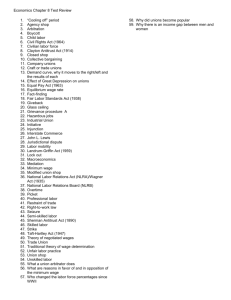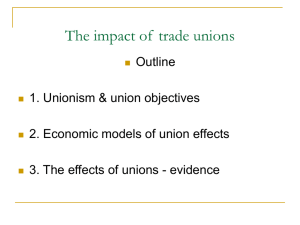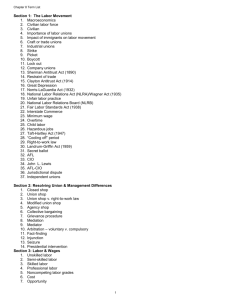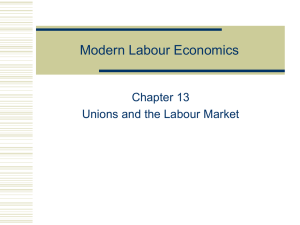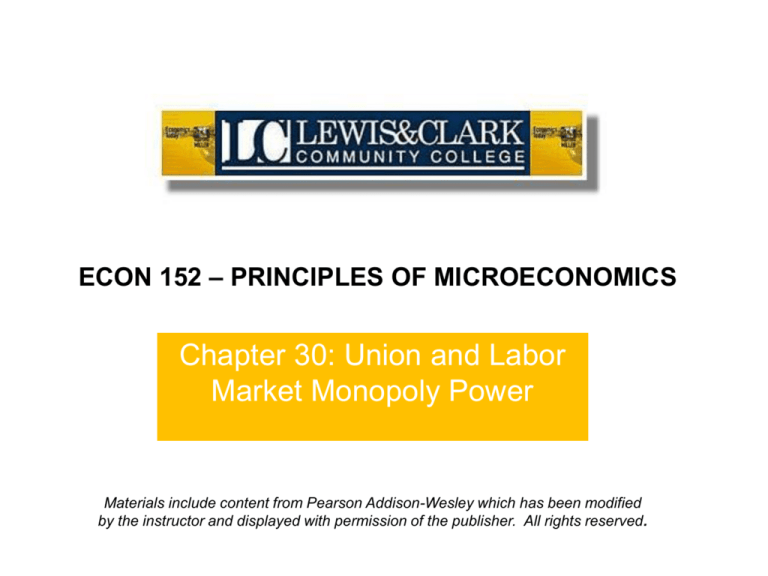
ECON 152 – PRINCIPLES OF MICROECONOMICS
Chapter 30: Union and Labor
Market Monopoly Power
Materials include content from Pearson Addison-Wesley which has been modified
by the instructor and displayed with permission of the publisher. All rights reserved.
Industrialization and Labor Unions
Craft Unions
Labor
unions composed of workers who
engage in a particular trade or skill
Knights of Labor
American Federation of Labor
2
Industrialization and Labor Unions
Collective Bargaining
Bargaining
between the management of a
company or of a group of companies and the
management of a union or a group of unions
for the purpose of setting a mutually
agreeable contract on wages, fringe benefits,
and working conditions for all employees in all
the unions involved
3
Industrialization and Labor Unions
The Congress of Industrial Organization (CIO)
was formed in 1938.
It was composed mainly of industrial unions.
Industrial unions consist of workers in a
particular industry, regardless of the skills they
use on the job.
4
Industrialization and Labor Unions
Congressional control over labor unions
The Wagner Act (1935)
Gave unions the right to organize workers and to engage
in collective bargaining
Taft-Hartley Act of 1947
Allow right-to-work laws
Laws that make it illegal to require union membership as a
condition of continuing employment in a particular firm
Made closed shops illegal
A business enterprise in which employees must belong to
the union before they can be hired and must remain in the
union after they are hired
5
Closed Shop
An enterprise in which employees must belong to the union before they
can be hired and must remain in the union after they are hired
Union Shop
An enterprise in which employees must belong to the union after they
are hired and complete a probationary period of employment
Agency Shop
An enterprise in which employees must pay the equivalent of union
dues whether they choose to, or not to, belong to the union after they
are hired and complete a probationary period of employment
Open Shop
An enterprise in which employees are never required to join a union or
pay the equivalent of union dues if they choose not to belong to the
union
6
7
Industrialization and Labor Unions
Congressional control over labor unions
Taft-Hartley
Prohibited jurisdictional disputes
Disputes involving two or more unions over which
should have control of a particular jurisdiction
Prohibited sympathy strikes
Act of 1947 (..continued)
A strike by a union in sympathy with another union’s
strike or cause
Prohibited secondary boycotts
A boycott of companies or products sold by companies
that are dealing with a company being struck
8
Industrialization and Labor Unions
Congressional control over labor unions
Taft-Hartley
Act of 1947
Established the 80-day-cooling-off period
A court injunction can be used to delay a strike if
it would imperil the nation’s safety or health.
9
Decline in U.S. Union Membership
Figure 30-2
10
Industrialization and Labor Unions
Explaining the fall in union membership
Deregulation
Immigration
Shift
from manufacturing to services
Labor legislation
Foreign competition
11
Union Goals and Strategies
Strikes: the ultimate bargaining tool
Purpose
is to impose costs and reduce profits
of the employer
Workers do not receive wages during the time
of the strike, but they may receive some
compensation from the union strike fund.
12
Union Goals and Strategies
Strikebreakers can reduce the bargaining
power of the strike
Temporary or permanent workers hired by a
company to replace union members who are
striking
13
Union Goals and Strategies
One of the major roles of a union that
establishes a wage rate above the market
clearing wage rate is to ration available
jobs among the excess number of workers
who wish to work in unionized industries.
14
Unions Must Ration Jobs
Wage Rate per Hour
S
WU
A
B
E
We
D
QD
Figure 30-3
Qe
QS
Quantity of Labor per Time Period
15
Union Goals and Strategies
Unions must ration the available
jobs by:
Seniority
Apprenticeship
16
Union Goals and Strategies
Unions are monopoly sellers of a service
Three wage and employment strategies
Employ
all union members
Maximize member income
Maximize wages for certain workers
17
Wage Rate per Hour
Union Goals and Strategies
Maximum total union
member income earned
W3
W2
W1
D
MR
0
Figure 30-4
Q3
Q2
Q1
Quantity of Labor per Time Period
18
Union Goals and Strategies
Limiting entry over time
One
way to raise wage rates without
specifically setting wages is for a union to limit
the size of its membership to the size of its
employed workforce when the union was first
organized.
19
Restricting Supply Over Time
If union membership limited
to Q1, wages increase to 21
instead of 20 and employment
is reduced
Figure 30-5
20
Union Goals and Strategies
Altering the demand for union labor
Increasing
worker productivity
Increasing the demand for union-made goods
Decreasing the demand for non-union-made
goods
21
Economic Effects of Labor Unions
Unions are able to raise wages if they can
successfully limit the supply of labor in a
particular industry.
Economists estimate that the average union
wage premium is $2.25 an hour.
But annual earnings for union workers are not
necessarily higher, because they work
somewhat fewer hours.
22
Economic Effects of Labor Unions
How do unions affect labor productivity?
There
is some evidence that featherbedding
creates inefficiency in the unionized
industries.
Some economists argue that unions actually
enhance productivity by reducing labor
turnover.
23
Monopsony:
A Buyer’s Monopoly
Assumptions
Firm
is perfect competitor in the product market: it
cannot alter the price of the product it sells and it
faces a perfectly elastic demand curve for its product
The
firm is the only buyer of a particular input
The buyer of labor is called a monopsonist, the
single buyer.
24
Monopsony:
A Buyer’s Monopoly
The monopsonist faces an upward-sloping
supply curve of labor.
Consequently, the marginal factor cost of
increasing the labor input by one unit is
greater than the wage rate.
Thus the marginal factor cost curve always
lies above the supply curve.
25
Derivation of a Marginal
Factor Cost Curve
Figure 30-7, Panel (a)
26
Derivation of a Marginal
Factor Cost Curve
Figure 30-7, Panel (b)
27
Monopsony:
A Buyer’s Monopoly
Monopsonistic Exploitation
Exploitation
due to monopsony power: It leads to a
price for the variable input that is less than its
marginal revenue product. Monopsonistic exploitation
is the difference between marginal revenue product
and the wage rate.
Bilateral Monopoly
A
market structure consisting of a monopolist and a
monopsonist
28
MFC, MRP, and Wage Rate per Worker-Week ($)
Wage and Employment Determination
for a Monopsonist MFC
Figure 30-8
MRP > W
S
A
We
Hire Qm where
MFC = MRP and
pay Wm
Wm
MRP
Qm
Qe
Labor Input (worker-weeks)
29
Pricing and Employment
Under Various Market Conditions
Wage Rate and Marginal
Revenue Product per Hour($)
Panel (a)
Firm operating in perfect
competition in both
input and output markets
Labor supply
We
MRPc
Competitive Input,
Competitive Output
Qe
Figure 30-9, Panel (a)
Quantity of Labor per
Time Period
30
Pricing and Employment
Under Various Market Conditions
Wage Rate and Marginal
Revenue Product per Hour($)
Panel (b)
Firm operating in perfect
competition in the input
market but a monopoly in
the output market
Labor supply
We
Why are fewer workers
hired in this market
compared to perfect
competition in both markets?
Figure 30-9, Panel (b)
Competitive Input,
MRPm Monopoly Output
Qm
Quantity of Labor per
Time Period
31
Wage Rate, Marginal Factor Cost, and
Marginal Revenue Product per Hour ($)
Pricing and Employment
Under Various Market Conditions
Panel (c)
Firm operating as
monopsonist in the
input market and a
perfect competitor
in the output market
MFC
S
• Hire where MFC = MRPc
• W = WC
• WC < MRP
Wc
MRPc
Monopsony Input,
Competitive Output
Q1
Figure 30-9, Panel (c)
Quantity of Labor per
Time Period
32
Wage Rate, Marginal Factor Cost, and
Marginal Revenue Product per Hour ($)
Pricing and Employment
Under Various Market Conditions
Panel (d)
MFC
Firm operating as
a bilateral monopoly
S
• Hire where MFC = MRPm
Wm
MRPm
Monopsony Input,
Monopoly Output
Q2
Figure 30-9, Panel (d)
Quantity of Labor per
Time Period
33
Repeated on
one page…
Pricing and
Employment
Under
Various
Market
Conditions
Competitive Input,
Competitive Output
Monopsony Input,
Competitive Output
Competitive Input,
Monopoly Output
Monopsony Input,
Monopoly Output
34
ECON 152 – PRINCIPLES OF MICROECONOMICS
Chapter 30: Union and Labor
Market Monopoly Power
Materials include content from Pearson Addison-Wesley which has been modified
by the instructor and displayed with permission of the publisher. All rights reserved.

